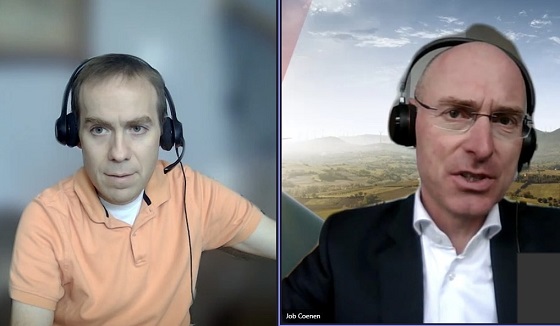Job Coenen, AkzoNobel’s sustainability program manager and a strategic global corporate advisory board member of the World Green Building Council, recently joined the CoatingsPro Interview Series of podcasts to discuss how sustainable solutions for the built environment can address the challenges of producing more green buildings.
Discussion topics on the newly released episode include the role of circularity in product development, science-based targets and goals, and how new technologies can help. Read on for a partial Q&A transcript of that conversation, and check out the full interview online at www.coatingspromag.com/podcasts or at the embedded link beneath this article.
Q: One of the themes you hear throughout the industry is this notion of a circular economy. Could you explain what that is and how a paints and coatings company, such as AkzoNobel, can potentially achieve that? And how does it fit in with broader sustainability initiatives?
 Coenen: Circularity in the built environment is important, particularly where a lot of resources are being used to construct or renovate these buildings. Currently, we need a lot of resources for that. The built environment, in certain countries and regions in the world, is responsible for up to 50% of raw material resources.
Coenen: Circularity in the built environment is important, particularly where a lot of resources are being used to construct or renovate these buildings. Currently, we need a lot of resources for that. The built environment, in certain countries and regions in the world, is responsible for up to 50% of raw material resources.
As such, if you think about carbon footprint, we’re talking around 40% of the overall carbon footprint that we have, as humans, actually comes from the built environment.
Now, circularity is getting more attention, because people realize that we can’t go on like this. We have to start reusing more of the materials we already have available. So, you will see in different countries and regions in the world … that when buildings are being demolished, we want to try and reuse some of those materials.
Being based in the Netherlands, I see that happening everywhere. The built environment, and the building sector itself, is trying to reuse more and more materials … to reduce the need and demand on our version of raw materials.
When I look across all the different market segments to which AkzoNobel provides paints and coatings, we see that a key driver for circularity is actually the carbon footprint reduction. Also, in paints and coatings, about 11–12% of the carbon footprint, globally, comes from end of life. The carbon, which sits in those paints and coatings that are ending up at their end of life, and that is where you can use more renewable or recycled raw materials.
So, at AkzoNobel, we have different programs in place to increase the amount of recycled or renewable raw materials in our paints and coatings. But actually, the real historical reason why people actually use coatings is to protect a substrate. That is also something we should not forget: protecting. Building materials, if we talk about the built environment, is very important.
Because you will use less new building materials in the future if you want to maintain that built environment. That’s something we often might not think about. We also have a role to play there, in that we have to kind of educate and help our customers decide and choose those more sustainable and longer-lasting solutions. That way, they can make sure that whatever has been coated remains alive and in good shape over time.
Q: You mentioned that people realize we can’t go on like this. How much of that is being industry driven, and how much of that is policy driven … at a government level?
Coenen: Good question. Both topics are very valid and important. We see more demand for the use of renewable raw materials coming actually from consumers. You and me, we buy all kinds of consumer goods. Whether that’s a beauty product or maybe a household product, we as consumers … once we realize that we can’t go on like this, we do put a value on that.
And the manufacturers of those products start using more renewable raw materials, and they recycle more. You see that happening a lot in packaging materials more and more … and also in the end product itself.
 Governments are also trying to develop policies. If we look at the built environment, a lot of it, historically, has been focused on reducing the carbon footprint and trying to reduce the energy usage in buildings. That’s the operational carbon. But more and more, you see attention being given to the embodied carbon in buildings. That’s where circularity will play a role.
Governments are also trying to develop policies. If we look at the built environment, a lot of it, historically, has been focused on reducing the carbon footprint and trying to reduce the energy usage in buildings. That’s the operational carbon. But more and more, you see attention being given to the embodied carbon in buildings. That’s where circularity will play a role.
I think governments are creating policies to stimulate, or even oblige, the private sector to use more renewable raw materials. For any public buildings and public activities, as we are talking about the built environment, that is where the government can really play a role.
Their specifications and requirements can include, for instance, a minimum level of renewable content in the building materials for those buildings. It can be the educational sector, right? Or other kinds of government buildings. That will really give a great push. Because if that starts, then, of course, a large part of the sector will move. Because construction companies and stakeholders throughout the value chain will see that demand growing from the public sector. I think governments may underestimate the power and opportunity they have to play a role there.
Q: Let’s talk about the technologies that can play a role in that transition. What sustainability solutions are out there to help address the challenge of producing more green buildings?
Coenen: Green buildings, as we call them, are focused on a few key areas. You can maybe group them under three headers:
- climate change, with a carbon footprint reduction;
- the circular economy, i.e. how do you use less fossil raw materials; and
- third, health and well-being. That is how, how do you contribute to the well-being of people living and working in buildings?
In all of those three groups, we have technologies that can help people who are living and working in these kinds of buildings … as well as achieving some of those targets that have been set for the built environment.
For a carbon footprint reduction, a few years ago, we at AkzoNobel set a target — and got it approved by SBTi [the Science-Based Targets initiative] — of reducing our carbon footprint by 50% by the year 2030. That’s not only for our own operation, but in our whole value chain, upstream and downstream.

When you talk about new technologies, that’s where we are reaching out to our suppliers and asking them to develop actually raw materials that have a lower carbon footprint. So, our suppliers are reducing their Scope 1 and Scope 2 emissions.
There’s also, of course, downstream. That’s where we need to work with customers. Because in those technologies and solutions, we have products that might need less energy for curing. For instance, in particular market segments, some of our customer groups are using a lot of energy, relatively, to cure coatings. So, we can play a role and help our customers move towards lower-baking or even ambient-curing type of technologies.
That is on the climate change side. On the circular topic and raw material usage, you can think of becoming much more efficient. Here, we can help customers with new technologies. Maybe not just with products but also with tools to reduce material use and waste.
One technology of note is powder coatings. Historically, a lot of building materials have been coated with liquid coatings, and we do develop and sell liquid coatings. We also have sustainability programs in place to make those kinds of coatings more sustainable.
But we are also in favor of developing the application of powder coatings. Those do not have VOCs [volatile organic compounds], so there are no solvents being used in powder coatings. Secondly, the efficiency — and particularly the material efficiency — is very high in powder coatings. So, we are trying to help some of customer groups move there.
The third group, with health and well-being, that’s where we focus on making sure that we develop our products with the chemical substances that are accepted by society. And secondly, how can we of course bring sustainability benefits — or health and well-being benefits — to customers who actually live and work in buildings?
Here, you can think of indoor air quality. If you work all day in a building, you want to make sure that the indoor air quality is good. There, we have different technologies. Technologies affect coatings that might emit less solvents, or other chemical substances.
Job Coenen made these comments on a recent episode of the CoatingsPro Interview Series. To hear the complete episode, listen below.